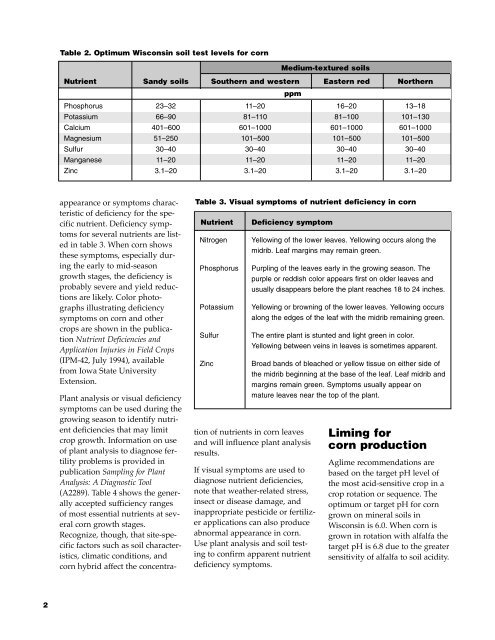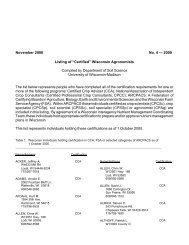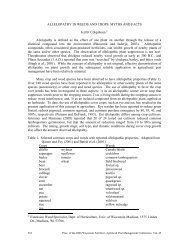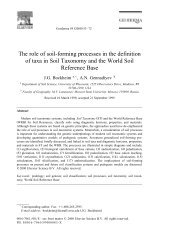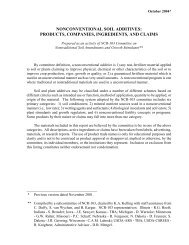Corn Fertilization (UWEX A3340) - Department of Soil Science ...
Corn Fertilization (UWEX A3340) - Department of Soil Science ...
Corn Fertilization (UWEX A3340) - Department of Soil Science ...
You also want an ePaper? Increase the reach of your titles
YUMPU automatically turns print PDFs into web optimized ePapers that Google loves.
2<br />
Table 2. Optimum Wisconsin soil test levels for corn<br />
Nutrient Sandy soils Southern and western Eastern red Northern<br />
Phosphorus 23–32 11–20 16–20 13–18<br />
Potassium 66–90 81–110 81–100 101–130<br />
Calcium 401–600 601–1000 601–1000 601–1000<br />
Magnesium 51–250 101–500 101–500 101–500<br />
Sulfur 30–40 30–40 30–40 30–40<br />
Manganese 11–20 11–20 11–20 11–20<br />
Zinc 3.1–20 3.1–20 3.1–20 3.1–20<br />
appearance or symptoms characteristic<br />
<strong>of</strong> deficiency for the specific<br />
nutrient. Deficiency symptoms<br />
for several nutrients are listed<br />
in table 3. When corn shows<br />
these symptoms, especially during<br />
the early to mid-season<br />
growth stages, the deficiency is<br />
probably severe and yield reductions<br />
are likely. Color photographs<br />
illustrating deficiency<br />
symptoms on corn and other<br />
crops are shown in the publication<br />
Nutrient Deficiencies and<br />
Application Injuries in Field Crops<br />
(IPM-42, July 1994), available<br />
from Iowa State University<br />
Extension.<br />
Plant analysis or visual deficiency<br />
symptoms can be used during the<br />
growing season to identify nutrient<br />
deficiencies that may limit<br />
crop growth. Information on use<br />
<strong>of</strong> plant analysis to diagnose fertility<br />
problems is provided in<br />
publication Sampling for Plant<br />
Analysis: A Diagnostic Tool<br />
(A2289). Table 4 shows the generally<br />
accepted sufficiency ranges<br />
<strong>of</strong> most essential nutrients at several<br />
corn growth stages.<br />
Recognize, though, that site-specific<br />
factors such as soil characteristics,<br />
climatic conditions, and<br />
corn hybrid affect the concentra-<br />
tion <strong>of</strong> nutrients in corn leaves<br />
and will influence plant analysis<br />
results.<br />
If visual symptoms are used to<br />
diagnose nutrient deficiencies,<br />
note that weather-related stress,<br />
insect or disease damage, and<br />
inappropriate pesticide or fertilizer<br />
applications can also produce<br />
abnormal appearance in corn.<br />
Use plant analysis and soil testing<br />
to confirm apparent nutrient<br />
deficiency symptoms.<br />
Medium-textured soils<br />
ppm<br />
Table 3. Visual symptoms <strong>of</strong> nutrient deficiency in corn<br />
Nutrient Deficiency symptom<br />
Nitrogen Yellowing <strong>of</strong> the lower leaves. Yellowing occurs along the<br />
midrib. Leaf margins may remain green.<br />
Phosphorus Purpling <strong>of</strong> the leaves early in the growing season. The<br />
purple or reddish color appears first on older leaves and<br />
usually disappears before the plant reaches 18 to 24 inches.<br />
Potassium Yellowing or browning <strong>of</strong> the lower leaves. Yellowing occurs<br />
along the edges <strong>of</strong> the leaf with the midrib remaining green.<br />
Sulfur The entire plant is stunted and light green in color.<br />
Yellowing between veins in leaves is sometimes apparent.<br />
Zinc Broad bands <strong>of</strong> bleached or yellow tissue on either side <strong>of</strong><br />
the midrib beginning at the base <strong>of</strong> the leaf. Leaf midrib and<br />
margins remain green. Symptoms usually appear on<br />
mature leaves near the top <strong>of</strong> the plant.<br />
Liming for<br />
corn production<br />
Aglime recommendations are<br />
based on the target pH level <strong>of</strong><br />
the most acid-sensitive crop in a<br />
crop rotation or sequence. The<br />
optimum or target pH for corn<br />
grown on mineral soils in<br />
Wisconsin is 6.0. When corn is<br />
grown in rotation with alfalfa the<br />
target pH is 6.8 due to the greater<br />
sensitivity <strong>of</strong> alfalfa to soil acidity.


